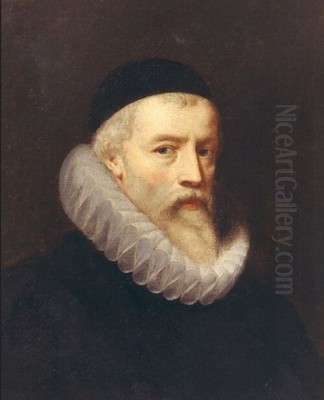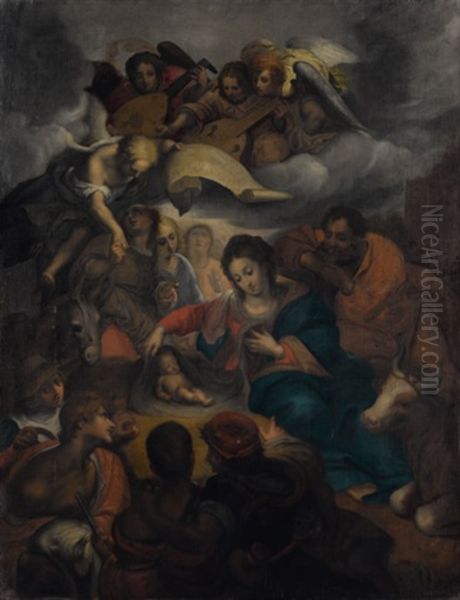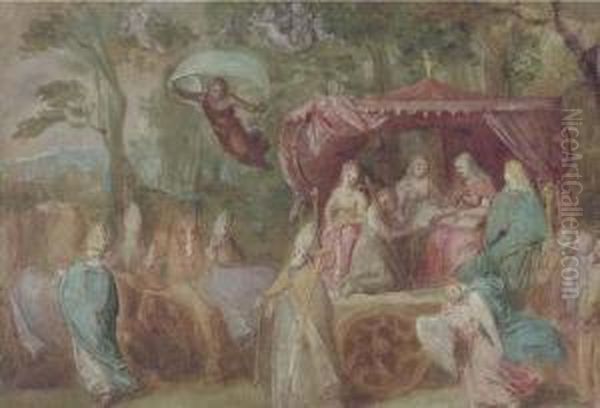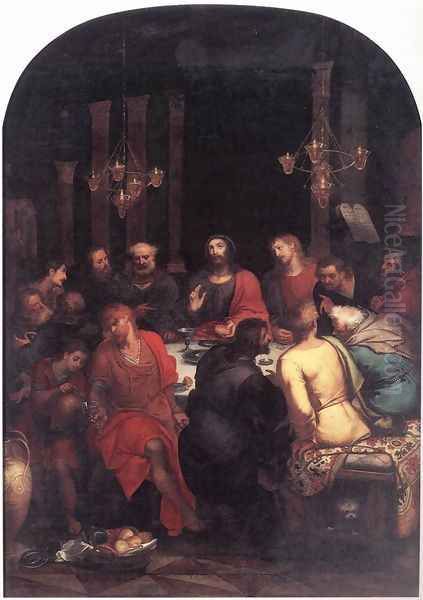
Otto van Veen, also known by his Latinized names Octavius Vaenius or Otto Venius, stands as a significant and often underappreciated figure in the art history of the Low Countries. Born in Leiden in the Habsburg Netherlands around 1556 and passing away in Brussels in 1629, Van Veen was a versatile artist: a painter, a draughtsman, and a prominent humanist scholar. His career bridged the late Flemish Renaissance and the burgeoning Baroque era, and his influence, particularly as the teacher of the celebrated Peter Paul Rubens, was profound. His work reflects a deep engagement with classical learning, Italian artistic innovations, and the intellectual currents of his time, making him a fascinating subject for study.
Early Life and Formative Education
Otto van Veen's origins lay in Leiden, a city in the northern part of the Netherlands. His family was aristocratic, which likely afforded him access to a quality education from a young age. This classical schooling would become a cornerstone of his artistic and intellectual identity throughout his life. His initial artistic training is believed to have been under Isaac Claesz. van Swanenburgh in Leiden. However, the religious and political turmoil of the Dutch Revolt significantly impacted his early years. As a Catholic family in a region increasingly dominated by Protestantism, the Van Veens found their position precarious.
Around 1572, following the capture of Leiden by Protestant rebels, the family relocated, first to Antwerp and then to Liège. It was in Liège that Van Veen continued his artistic and humanist studies under Dominicus Lampsonius. Lampsonius was himself a notable figure – a humanist, poet, and painter, who had corresponded with luminaries like Giorgio Vasari. Under Lampsonius, Van Veen would have further honed his understanding of classical literature and art theory, an education that was considered essential for an ambitious artist of the period. This mentorship undoubtedly reinforced Van Veen's scholarly inclinations.
The Italian Sojourn: Immersion in Renaissance Ideals

Like many Northern European artists of his generation, a journey to Italy was a crucial step in Van Veen's artistic development. Around 1574 or 1575, he embarked on this transformative trip, spending approximately five to eight years on the Italian peninsula, primarily in Rome. Italy was the wellspring of the Renaissance, and exposure to its artistic treasures – both ancient and contemporary – was considered indispensable.
During his time in Rome, Van Veen is thought to have worked with or studied under Federico Zuccaro, a prominent Mannerist painter. Zuccaro's style, characterized by elongated figures, complex compositions, and a certain artificial elegance, would have been a significant influence. Beyond specific tutelage, Van Veen immersed himself in the study of classical antiquity, absorbing the lessons of Roman sculpture and architecture. He also diligently studied the works of High Renaissance masters such as Raphael and Michelangelo, and contemporary Mannerists. The influence of artists like Correggio and Parmigianino, known for their graceful figures and sophisticated use of light and color, is particularly evident in Van Veen's later work. This period in Italy equipped him with a refined technique, a deep understanding of human anatomy and perspective, and a rich iconographic vocabulary drawn from classical mythology and history.
Return to the North and Rise to Prominence
Upon his return from Italy, likely around 1583, Van Veen's career began to flourish. He initially found employment at various courts, including that of Rudolf II in Prague and William V of Bavaria in Munich, though his stays there were relatively brief. He also served Alessandro Farnese, Duke of Parma and Piacenza, who was the Governor of the Spanish Netherlands. This connection highlights Van Veen's ability to secure patronage at the highest levels.
By the late 1580s or early 1590s, Van Veen had settled in Antwerp, which was then a major artistic and commercial hub in the Southern Netherlands. In 1592, he became a master in the Antwerp Guild of Saint Luke, the city's venerable institution for painters and other craftsmen. His classical learning, refined Italianate style, and courtly connections quickly established him as one of the leading artists in the city. He served as dean of the Guild in 1602, a testament to his esteemed position among his peers. His workshop became highly regarded, attracting ambitious young artists.

Later in his career, around 1615, Van Veen moved to Brussels, the administrative capital of the Spanish Netherlands. There, he continued to enjoy significant patronage, notably from the Archdukes Albert VII and Isabella Clara Eugenia, who were avid patrons of the arts. He served as their court painter, a prestigious role that further solidified his reputation.
Artistic Style: A Synthesis of Mannerism and Classicism
Otto van Veen's artistic style is a complex amalgamation of various influences, primarily Italian Mannerism and a deeply ingrained classicism. His work often displays the elegant, elongated figures, sophisticated compositions, and refined color palettes characteristic of late Mannerism. This can be seen in the graceful, sometimes contorted, poses of his figures and the intellectual complexity of his allegorical and mythological scenes.
However, Van Veen's Mannerism was tempered by a strong classical sensibility. His compositions, while often intricate, generally maintain a sense of order and clarity. He paid close attention to anatomical accuracy and the harmonious arrangement of figures within a well-defined space. This classical leaning was undoubtedly nurtured by his humanist education and his direct study of ancient art in Italy. He sought to imbue his works with a sense of gravitas and intellectual depth, often drawing on classical literature, history, and philosophy for his subject matter.
His paintings are characterized by a smooth, polished finish and a careful attention to detail. While his palette could be rich and varied, it often favored more subdued and harmonious color schemes compared to the more dramatic and vibrant colors that would characterize the subsequent Baroque era. He was a master of conveying emotion through subtle gesture and expression, and his religious works often possess a quiet piety and contemplative mood.
Major Works and Thematic Concerns
Otto van Veen's oeuvre encompasses a wide range of subjects, including religious scenes, mythological narratives, allegories, and portraits. He was also a prolific designer of emblem books, which were immensely popular during the Renaissance and Baroque periods.
Religious Paintings:

Many of Van Veen's most important commissions were for altarpieces and other religious works for churches and private chapels. The Adoration of the Shepherds is a fine example of his religious painting, showcasing his ability to handle complex multi-figure compositions with grace and sensitivity. The figures are rendered with a soft modeling, and the scene is imbued with a serene, devotional atmosphere. Another notable religious work is The Mystic Marriage of Saint Catherine, which displays the elegant figural types and refined execution typical of his style, clearly showing the influence of Italian masters like Correggio and Parmigianino. His religious works often reflect the Counter-Reformation's emphasis on clarity, piety, and emotional engagement, though filtered through his learned, classicizing lens.
Mythological and Allegorical Works:
Van Veen's humanist background made him particularly adept at mythological and allegorical subjects, which allowed him to showcase his erudition and artistic skill. These works often carried complex moral or philosophical messages, appealing to a sophisticated and educated audience. His figures in these scenes are typically idealized, drawing on classical prototypes, and the compositions are carefully constructed to convey the narrative or allegorical meaning.
Emblem Books:
Perhaps one of Van Veen's most distinctive contributions was in the field of emblem books. These books combined images (picturae) with mottos (inscriptiones) and explanatory verses (subscriptiones) to convey moral, philosophical, or amorous lessons. Van Veen was a master of this genre, designing numerous influential emblem books.
Among his most famous is Amorum Emblemata (Emblems of Love), published in 1608. This work, featuring charming illustrations of Cupid in various guises, explored the multifaceted nature of profane love and became incredibly popular, being translated into several languages.
Another significant work was Amoris Divini Emblemata (Emblems of Divine Love), published in 1615. In contrast to the earlier book, this one focused on sacred love, depicting the soul's relationship with God, often personified by figures like Anima (the Soul) and Divine Love (often represented as Christ or an angel).
He also produced Quinti Horatii Flacci Emblemata (1607), which illustrated maxims from the Roman poet Horace, demonstrating his deep engagement with classical literature. These emblem books were not only artistic achievements but also important cultural artifacts, disseminating classical and humanist ideas to a wider audience. Their influence extended to other artists and writers across Europe.
The Teacher of Rubens
One of Otto van Veen's most enduring legacies is his role as the teacher of Peter Paul Rubens, who would go on to become the preeminent Flemish Baroque painter. Rubens entered Van Veen's studio around 1594 or 1595 and remained with him for about four years, until approximately 1598. This was a critical period in Rubens's formation.
Van Veen's studio was an ideal environment for the young Rubens. He would have received a thorough grounding in the fundamentals of painting, including drawing, composition, and the use of color. More importantly, Van Veen's humanist leanings and his extensive knowledge of classical art and literature would have profoundly influenced Rubens. Van Veen likely encouraged Rubens's own classical studies and instilled in him an appreciation for Italian art. It is widely believed that Van Veen advised Rubens to undertake his own journey to Italy, a trip that would prove transformative for the younger artist.
While Rubens's mature style would diverge significantly from Van Veen's more restrained classicism, developing into the dynamic and exuberant Baroque, the intellectual discipline and classical foundation acquired in Van Veen's workshop remained with him throughout his career. Van Veen provided Rubens not just with technical skills but with an intellectual framework that shaped his approach to art. Other artists who spent time in Van Veen's studio, or were his contemporaries in Antwerp, included Adam van Noort (another of Rubens's early teachers), and he would have been aware of the work of earlier Antwerp masters like Frans Floris I and Maarten de Vos, whose Italianate styles had paved the way for artists like Van Veen.
Humanism and Intellectual Pursuits
Otto van Veen was more than just a painter; he was a true uomo universale in the Renaissance tradition, a learned humanist deeply engaged with the intellectual currents of his time. His classical education under figures like Dominicus Lampsonius provided him with a strong foundation in Latin, Greek, and classical literature, which he drew upon extensively in his art and writings.
His emblem books are the most explicit manifestation of his humanist scholarship. They demonstrate not only his artistic skill in designing the illustrations but also his erudition in selecting and interpreting classical and contemporary texts. These books were intended for an educated readership and participated in the broader humanist project of reviving and reinterpreting classical wisdom for a contemporary audience.
Van Veen's intellectual circle would have included other scholars, poets, and patrons who shared his interest in classical antiquity and humanist thought. His ability to converse in Latin, the lingua franca of European intellectuals, would have facilitated these connections. His art, therefore, should be seen not merely as decorative but as a form of visual rhetoric, intended to instruct, delight, and persuade, in line with classical ideals of art's purpose. This intellectual depth distinguished him from many of his contemporaries and contributed to his high standing in society.
Contemporaries and the Artistic Milieu of Antwerp
Otto van Veen operated within a vibrant and competitive artistic environment, particularly during his years in Antwerp. The city was a crucible of artistic innovation, attracting talent from across the Low Countries and beyond.
His most famous pupil, Peter Paul Rubens, would soon eclipse him in fame, ushering in the High Baroque style. Other notable Antwerp painters active during Van Veen's time, or slightly preceding him and setting the stage, included:
Frans Floris I (c. 1519–1570): An earlier Romanist whose large-scale altarpieces and mythological scenes helped popularize Italianate styles in Antwerp.
Maarten de Vos (1532–1603): A prolific contemporary who also spent time in Italy and produced a vast number of paintings and designs for prints, often with a similarly elegant, late Mannerist feel.
Adam van Noort (1561/62–1641): Another of Rubens's teachers, known for his robust figure style. He and Van Veen were leading figures in the Antwerp Guild of St. Luke.
Hendrick de Clerck (c. 1560–1630): A Brussels-based contemporary who also worked for the Archdukes and shared a late Mannerist style.
Abraham Janssens (c. 1575–1632): A slightly younger contemporary and, for a time, a rival to Rubens, known for his powerful, classicizing figures and Caravaggesque tendencies.
Frans Pourbus the Younger (1569–1622): A renowned portrait painter who worked for various European courts, continuing a strong Netherlandish tradition.
Jan Brueghel the Elder (1568–1625): A close friend and collaborator of Rubens, famous for his detailed flower paintings and landscapes.
In Italy, Van Veen was influenced by High Renaissance masters like Raphael, and Mannerists such as Federico Zuccaro, Correggio, and Parmigianino. The broader European context also included influential figures like Hendrick Goltzius (1558-1617) in the Northern Netherlands, a master of Mannerist printmaking and painting. This rich tapestry of artistic personalities and styles formed the backdrop against which Van Veen forged his own distinct artistic identity. His studio was one of the most respected, and his influence was felt not only through his students but also through the dissemination of his emblem books.
Later Years and Legacy
In his later years, after moving to Brussels around 1615, Otto van Veen continued to be active as a painter, primarily serving the court of the Archdukes Albert and Isabella. His status as court painter ensured a steady stream of prestigious commissions. He also continued his scholarly pursuits, and his reputation as a learned artist remained undiminished. He passed away in Brussels on May 6, 1629.
Otto van Veen's legacy is multifaceted. Artistically, he played a crucial role in transmitting Italian Renaissance and Mannerist ideals to the Southern Netherlands, adapting them into a refined and intellectual style that appealed to both ecclesiastical and courtly patrons. His emphasis on classical learning and decorum provided a sophisticated alternative to some of the more flamboyant trends of his time.
His most significant impact, arguably, was through his role as a teacher, particularly of Peter Paul Rubens. By providing Rubens with a strong foundation in classical art and humanist thought, Van Veen helped shape the intellectual underpinnings of the artist who would come to define Flemish Baroque painting.
Furthermore, his emblem books enjoyed widespread popularity and influence throughout Europe. They were translated into multiple languages and served as source material for other artists and writers, contributing to the rich visual and literary culture of the period. Works like Amorum Emblemata and Amoris Divini Emblemata remain important documents of Renaissance and Baroque attitudes towards love, morality, and spirituality.
Conclusion: An Erudite Master of Transition
Otto van Veen was a pivotal figure in Netherlandish art, an erudite master whose career spanned the transition from the late Renaissance to the early Baroque. A skilled painter, an influential teacher, and a respected humanist scholar, he embodied the Renaissance ideal of the learned artist. His deep engagement with classical antiquity and Italian art, combined with his own intellectual acuity, resulted in a body of work characterized by elegance, sophistication, and intellectual depth.
While perhaps overshadowed in popular imagination by his celebrated pupil, Rubens, Van Veen's contributions to the artistic and intellectual life of his time were substantial. His paintings graced churches and palaces, his emblem books captivated a wide readership, and his teachings helped to shape the next generation of Flemish artists. Otto van Veen remains a testament to the enduring power of classical learning and artistic skill, a distinguished artist who successfully navigated and enriched the complex cultural landscape of late sixteenth and early seventeenth-century Europe.